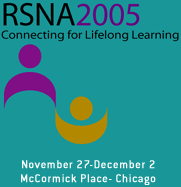
Abstract Archives of the RSNA, 2005
Tobias Daniel Henning MD, Presenter: Nothing to Disclose
Marc Huismann, Abstract Co-Author: Nothing to Disclose
Claudia Hillerer MD, Abstract Co-Author: Nothing to Disclose
Sibylle Ziegler, Abstract Co-Author: Nothing to Disclose
Heike E. Daldrup-Link MD, Abstract Co-Author: Nothing to Disclose
Ernst Josef Rummeny MD, Abstract Co-Author: Nothing to Disclose
To assess the imaging characteristics and pharmacokinetics of Fenestra LC, a new hepatobiliary contrast agent for CT
Fenestra LC is a new hepatobiliary contrast agent which mimics chylomicron remnants and is selectively taken up by hepatocytes via the apoE receptor. Fifteen female C3H mice were investigated at different time points: prior to injection, in 30min-intervals for 7 hours (h) post injection (p.i.), as well as at 24 h and 48 h p.i. of Fenestra LC at a dose of 20 µl/g body weight. All mice were imaged in a microCT (MicroCAT II, ImTEK Inc., Knoxville) using the following settings: x-ray voltage of 70 kVp, anode current of 500 µA and exposure time of 300 ms, 360 rotational steps resulting in a 103 µm isotropic spatial resolution. The contrast agent effect was determined quantitatively by measuring pre- and postcontrast hounsfield units of the liver, gall bladder, IVC and kidneys. Based on additional phantom measurements these data were converted to concentration-versus-time curves. Differences between pre- and postcontrast agent concentrations were tested for significance by analysis of variance.
Fenestra LC caused a marked and significant early postcontrast enhancement of blood in the IVC, which slowly declined to baseline values within 90 min. The liver parenchyma showed a slow contrast agent accumulation, a significant peak enhancement between 2 and 3 hours p.i. and a subsequent contrast agent excretion via the biliary system. Five hours p.i. a contrast enhancement in the duodenum was observed, corresponding to biliary excretion of contrast agent into the bowel, while the liver still showed a persistent enhancement. No significant renal excretion of the contrast agent was noticed.
Fenestra LC exhibits characteristics of a blood pool agent for CT, providing prolonged intravascular contrast enhancement. It also shows characteristics of a hepatobiliary contrast agent with specific liver uptake and slow excretion via the biliary system. Renal excretion was not observed.
Henning, T,
Huismann, M,
Hillerer, C,
Ziegler, S,
Daldrup-Link, H,
Rummeny, E,
Imaging Characteristics of a New Hepatocyte-selective Contrast Agent for CT. Radiological Society of North America 2005 Scientific Assembly and Annual Meeting, November 27 - December 2, 2005 ,Chicago IL.
http://archive.rsna.org/2005/4418901.html

